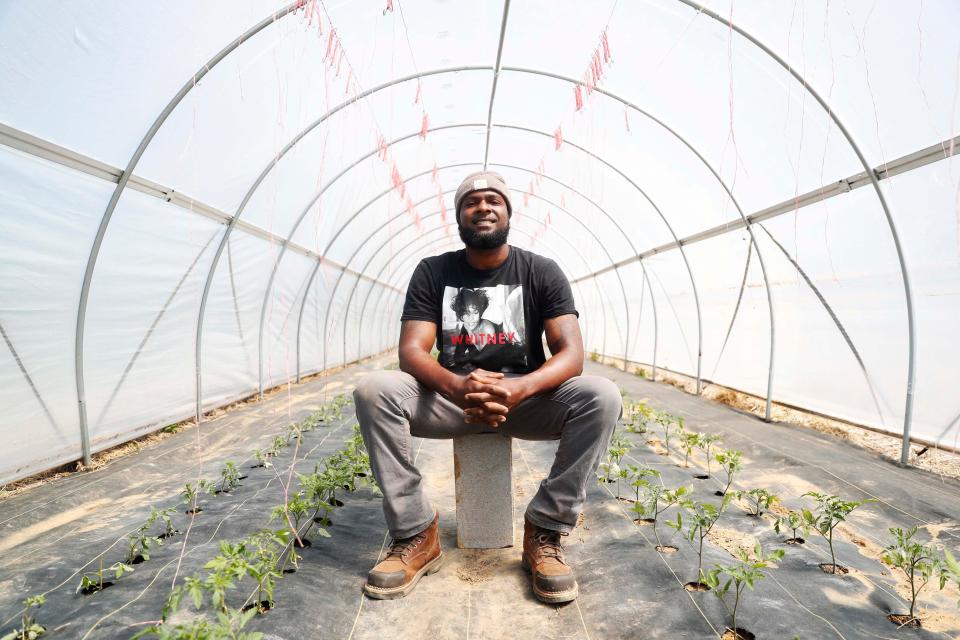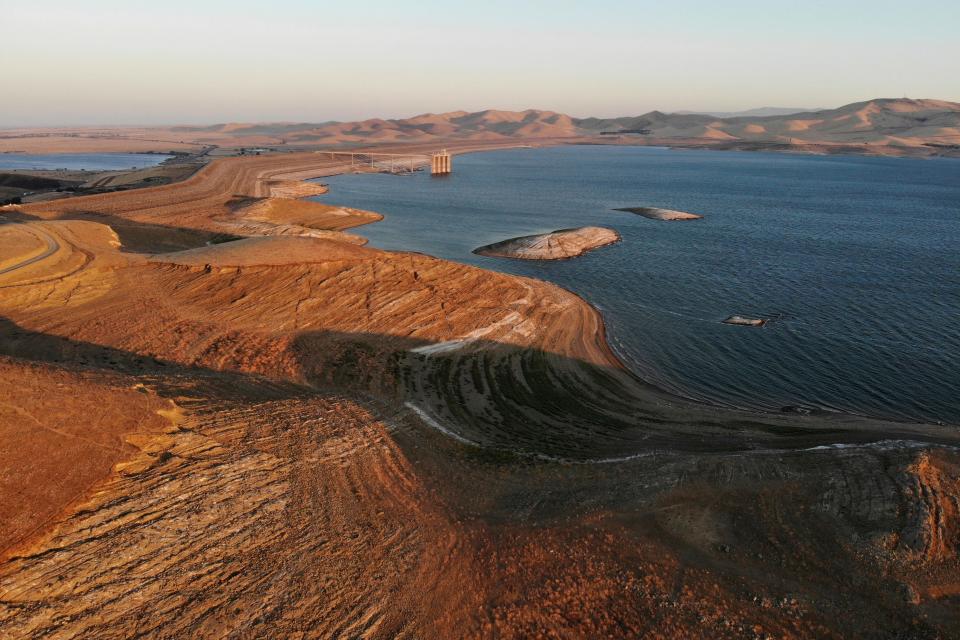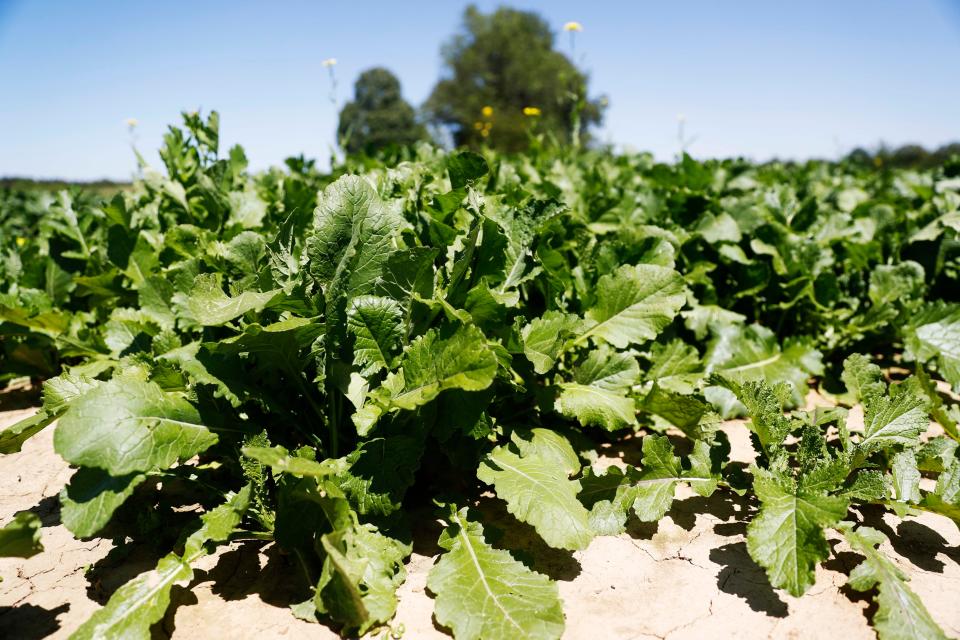Black farmers rethink Mississippi Delta's potential as climate change ravages California
Matthew Robinson’s family has owned and farmed 100 acres near Memphis, Tennessee, for four generations. The family bought the land with a loan from a local undertaker.
The undertaker was white. Robinson’s family is Black.
Had Robinson's family missed a payment, the land could have gone back to the undertaker. Robinson's family would have suffered the fate of so many Black famers. But Robinson's family managed to refinance with another company and secure the land they still farm today.
In 1910, Black farmers owned as much as 16 million acres. By the end of the 20th century, they lost 90% of that land. Over that same period, white farmers lost only 2% of their land. Acts of racism and a history of documented discrimination by the Department of Agriculture forced scores of Black farmers off their land. Today, fewer than 2% of American farmers are Black.

Robinson, 30, came to love this land as a teenager, when he visited from Nashville to hunt deer, squirrels and raccoons, and speed across the gentle slopes in four wheelers.
On a spring morning, he walked his 8 acres of fields, which surround the house where his grandmother used to live, and showed off plots planted with collards, cabbage, kale, eggplants, tomatoes and cucumbers. The shoots of the crops poked out of the ground like tufts of hair. Two hoop houses, basic greenhouses, needed repairs after April’s tornadoes.
The hum of the wind was punctuated by the chirps of birds and bugs. Robinson, muscular and with a trim beard, wore a Carhartt cap and a Whitney Houston T-shirt, and had the easy cool of a man from the city. But he belongs to this land. Most days he works his farm alone, although his family always surrounds him.
“There’s another part over there where my uncle Marvin farms. He’s right there. And then my two first cousins, they farm,” he said.
Most of his family are row crop farmers. They grow wheat and soy beans that stretch to the horizon in taut rows. Robinson learned to farm a different way at Tuskegee University, where he received both a bachelor’s and master’s degree. What he grows are called “specialty crops.” Almost all of the vegetables, fruits and nuts we eat are specialty crops rather than row crops, such as soy beans, cotton or wheat that are normally sold for slim profit margins on large exchanges.
That makes Robinson rare in this southwest corner of Tennessee and down through the Mississippi Delta, where little of the land is planted with specialty crops. In the United States, half of our specialty crops are grown in California. Climate change, however, has made the future of California agriculture cloudy.
Just out of sight of Robinson’s farm, construction workers buzz around BlueOval City, building a factory for Ford’s “next generation” electric truck. In the agriculture world, many in the region consider a future growing specialty crops to be as promising as one with pickups running on batteries.
More: Black farmers have lived here for generations. Now, a Ford plant is changing the landscape.
The Mississippi Delta and the surrounding region, with its abundant water, good soil and inexpensive land, could help feed America as climate change makes California’s farms struggle. The World Wildlife Fund has committed to turning eastern Arkansas, western Tennessee, southeastern Missouri and northwestern Mississippi into the “next California.” Robinson is part of the advisory panel guiding that project.
“Roughly less than a percent of the Delta land acres are in fruit and vegetable production now,” said Marty Matlock, a biosystems engineer at the University of Arkansas. “If we were to increase that to 5%, we would increase the economic value to $4.5 billion. We’re not talking about a whole transformation.”
The World Wildlife Fund and its partners – farmers, scientists, economists and directors of nonprofits – are currently working to make that change in the middle Mississippi Delta region. They are finding the crops and varietals of fruits and vegetables that will grow in the South. They are figuring out how many workers will be needed in those fields. And they are calculating the environmental advantages of specialty crops in the Mississippi Delta region.
The research began in 2022 and will continue through early 2024.
The wildlife fund and its partners also see a future for the region that fixes the injustices of the past.
“We want to focus on Black farmers,” said Julia Kurnik, who leads the Next California project for the fund. “In this region, Black farmers are the hardest hit group and the group that is disappearing.”
A new future for the Mississippi Delta
California, South Texas and Florida are where America grows fruits and vegetables. Climate change will affect all those regions, and farmers have already seen it.
The changes in some regions may still be subtle. Even in the South, colder temperatures that kept insects and bacteria in check are becoming less common.
But California’s Central Valley, where more than 250 crops are grown, has suffered through years of drought, and its groundwater supply is dwindling.
“Climate change is real in California. It’s not some future challenge,” Matlock said. “It’s been said that if climate change is a shark, water is its teeth."

The Delta will never be California. Not all of California's specialty crops can be successfully grown in the South. There is too much humidity and rain. Too many pests.
“We’re going to produce fruits and vegetables in California as long as we can, as long as we’ve got water,” Matlock said.
If land for specialty crops outside California is not developed, however, the variety of vegetables we eat could shrink. One day, grocery stores might no longer sell Roma tomatoes or butter leaf lettuce.
A future that fixes the past
When Marcus A. Coleman was in the agricultural economics graduate program at Michigan State University, several of his colleagues studied farming in the developing world. Coleman realized the problems they wanted to solve were the same ones found an hour away in Detroit. They were the same issues Coleman saw growing up in a small, predominantly Black town in the Louisiana corner of the Mississippi Delta. Coleman, now a professor at Tulane University, decided to focus his research closer to home.
“It was important for me, being in agriculture, to work on issues that affected people that looked like me, people that came from the type of places that I came from,” he said.
He thinks the goal of the Next California project, to engineer an increase in specialty crop production in the middle Delta region, is possible. He points to North Carolina. After tobacco farming collapsed, universities and the state helped farmers replace that crop with a wide-ranging local food system.
“By all accounts, it’s done pretty well,” Coleman said.
Coleman also believes support for specialty crops in the Mississippi Delta is an opportunity for Black farmers.
More: Could rice be the key to Southern Black farmers' battle against climate change?
Black farmers already grow more specialty crops than white farmers. They often have no choice. The average size of Black-owned farms is 132 acres, according to the USDA. The average farm in the United States is 445 acres. Specialty crops can make a small plot of land profitable. Successful row crop farms often require thousands of acres.
“You have to be a little more creative when you’re trying to earn an income on 15 or 20 acres,” said Trey Malone, an agricultural economist at the University of Arkansas.
Black farmers’ creativity, developed out of necessity, makes them potential leaders in a project that aims to grow new crops in the Delta.
How to change the land
Growing more fruits and vegetables in the Delta will not be easy. The area has water, but it also has more insects and weeds than California. The row crop farmers tackle those challenges by spraying herbicide and pesticide, which can drift into fields of specialty crops that are not genetically engineered to tolerate the chemicals.
Labor will also be needed. Row crop farms require only a few people guiding sophisticated, expensive equipment. Most specialty crops still need to be picked by hand. Researchers, however, are hopeful that automation will eventually reduce the need for fieldworkers.

Coleman, the Tulane professor, knows that a Black farmer who wants to grow specialty crops in the Delta region faces the same hurdles all Black farmers face. The USDA has a documented history of discriminating against Black farmers, allowing white farmers to grow generational wealth while Black farmers struggled and often left agriculture. Some Black farmers still report discrimination from government programs, even though the Biden administration has made support for Black and other disadvantaged farmers a priority.
“They still get the runaround. We know those inequities still exist across the system,” Coleman said.
Growing more fruits and vegetables in the Mississippi Delta region could be lucrative for farmers. Without regular outreach, the farmers who already have money and land, mainly white farmers, could get all the rewards of a shift toward specialty crops. Those who support the Next California project do worry about that outcome.
“For every opportunity that we present, there are always going to be threats that exist,” Coleman said.
Todd A. Price writes about food and culture in the South. He can be reached at taprice@gannett.com.
This article originally appeared on USA TODAY NETWORK: Black farmers rethink the South's potential in face of climate change

